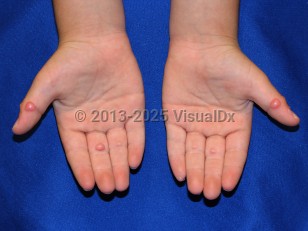Diagnosis is suspected based on clinical findings (cutaneous nodules and polyarthritis) and confirmed by biopsy.
- Histopathology remains the key to diagnosis.
- Radiologic testing can be used to look for evidence of joint destruction.
- Laboratory findings often demonstrate an elevation of nonspecific positive acute-phase reactants (inflammatory markers) such as erythrocyte sedimentation rate (ESR) and/or C-reactive protein (CRP). Serum testing for antinuclear antibodies, rheumatoid factor autoantibodies, and other serum antibodies (eg, anti-glomerular basement membrane antibodies, anti-neutrophil cytoplasmic antibodies) is routinely negative in the absence of concomitant rheumatic and non-rheumatic conditions.
The treatment for FR is anecdotal and primarily based on data from isolated case reports. Non-steroidal anti-inflammatory drug (NSAID) therapy, systemic corticosteroids, methotrexate (MTX), hydroxychloroquine, interferon-alfa, and colchicine are just some of the medications that have been tried to date. MTX has been used in a number of cases, many of which have had positive clinical responses, including marked improvement or resolution of joint pain and/or skin nodules. Moderate- to high-dose oral corticosteroids have also been used with some success.



